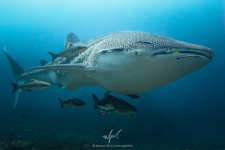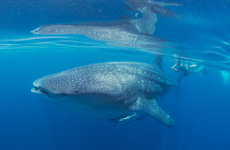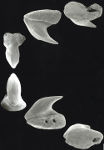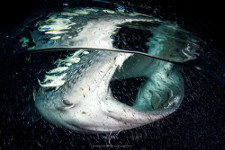Rhincodon typus
Smith, 1828
Classification: Elasmobranchii Orectolobiformes Rhincodontidae
Reference of the original description
Descriptions of new, or imperfectly known objects of the animal kingdom, found in the south of Africa. South African Commercial Advertiser, 3(145), 2
Descriptions of new, or imperfectly known objects of the animal kingdom, found in the south of Africa. South African Commercial Advertiser, 3(145), 2
Image of the original description
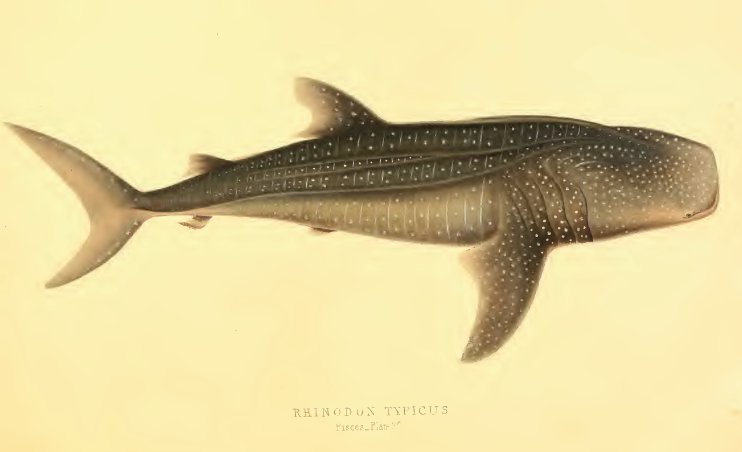
Rhinodon typicus Smith, 1845

Rhinodon typicus Smith, 1845
Synonyms / new combinations and misspellings
Micristodus punctatus, Rhincodon aff. typus, Rhincodon cf. typus, Rhineodon typicus, Rhineodon typus, Rhiniodon typus, Rhinodon pentalineatus, Rhinodon typicus
Micristodus punctatus, Rhincodon aff. typus, Rhincodon cf. typus, Rhineodon typicus, Rhineodon typus, Rhiniodon typus, Rhinodon pentalineatus, Rhinodon typicus
Types
Rhincodon typus
Holotype: MNHN: 9855
Micristodus punctatus
Holotype: USNM: 231756;
Rhinodon typicus
Holotype: MNHN: ?
Rhincodon typus
Holotype: MNHN: 9855
Micristodus punctatus
Holotype: USNM: 231756;
Rhinodon typicus
Holotype: MNHN: ?
Description :
Citation: Rhincodon typus Smith, 1828: In: Database of modern sharks, rays and chimaeras, www.shark-references.com, World Wide Web electronic publication, Version 01/2026
Please send your images of "Rhincodon typus" to info@shark-references.com
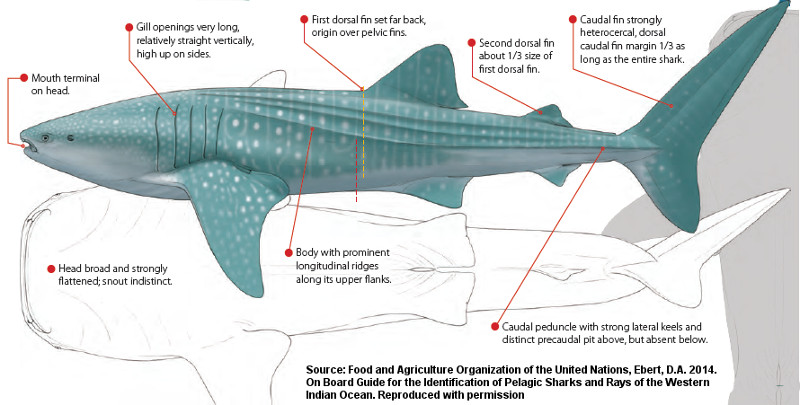
Rhincodon typus Smith, 1828; © FAO, Food and Agriculture Organization of the United Nations, Ebert, D.A. 2014. On Board Guide for the Identification of Pelagic Sharks and Rays of the Western Indian Ocean. Reproduced with permission, illustration by Marc Dando , Wildlife Illustrator

Rhincodon typus Smith, 1828; © FAO, Food and Agriculture Organization of the United Nations, Ebert, D.A. 2014. On Board Guide for the Identification of Pelagic Sharks and Rays of the Western Indian Ocean. Reproduced with permission, illustration by Marc Dando , Wildlife Illustrator
Common names
 Rauhhai,
Rauhhai,  Walhai,
Walhai,  Dámero,
Dámero,  Pez dama,
Pez dama,  Tiburon ballena,
Tiburon ballena,  Chagrin,
Chagrin,  Requin baleine,
Requin baleine,  Requin-baleine,
Requin-baleine,  Basking shark,
Basking shark,  Tofu sa,
Tofu sa,  Tofu shark,
Tofu shark,  Whale shark,
Whale shark,  Whaleshark,
Whaleshark,  Pintado,
Pintado,  Tubarão baleia,
Tubarão baleia,  Tubarão-baleia
Tubarão-baleia
 Rauhhai,
Rauhhai,  Walhai,
Walhai,  Dámero,
Dámero,  Pez dama,
Pez dama,  Tiburon ballena,
Tiburon ballena,  Chagrin,
Chagrin,  Requin baleine,
Requin baleine,  Requin-baleine,
Requin-baleine,  Basking shark,
Basking shark,  Tofu sa,
Tofu sa,  Tofu shark,
Tofu shark,  Whale shark,
Whale shark,  Whaleshark,
Whaleshark,  Pintado,
Pintado,  Tubarão baleia,
Tubarão baleia,  Tubarão-baleia
Tubarão-baleia
Short Description
A huge, blunt-headed shark with a terminal mouth and a prominent checkerboard pattern of light spots, horizontal and vertical stripes on a dark background [518] [536]. Caudal fin crescentic, with a strong lower lobe but no subterminal notch [16823]. It has small, scale-like teeth and feeds by filtering plankton with special sieve-like modifications of the gill bars [17659].
A huge, blunt-headed shark with a terminal mouth and a prominent checkerboard pattern of light spots, horizontal and vertical stripes on a dark background [518] [536]. Caudal fin crescentic, with a strong lower lobe but no subterminal notch [16823]. It has small, scale-like teeth and feeds by filtering plankton with special sieve-like modifications of the gill bars [17659].
Distribution
Circumglobal in tropical and warm temperate seas. Western Atlantic: New York, USA through the Caribbean to central Brazil. Eastern Atlantic: Senegal to Gulf of Guinea; St. Paul"quot;s Rocks [5002]. Indian Ocean: throughout the region, including the Red Sea and the Persian Gulf. Western Pacific: Japan to Australia and Hawaii. Eastern Pacific: California, USA to Chile. Identified as one of the species with an unfavorable conservation status in Appendix II of the Bonn Convention for the Conservation of Migratory Species of Wild Animals in 1999. Classified as a highly migratory species, in Annex I of the 1982 United Nations Convention on the Law of the Sea (UNCLOS) which called for "quot;coordinated management and assessment to better understand cumulative impacts of fishing effort on the status of the shared populations"quot; of these sharks [20076]. Included in Appendix II of the Convention on International Trade in Endangered Species of Wild Fauna and Flora (CITES) since May 2003 which regulates international trade of this species. This can partially implement the original objective of the FAO International Plan of Action for the Conservation and Management of Sharks (IPOA-Sharks). However, international trade still exists. First records: 2012: Portugal, in continental Europe, 07.10.2011, a 7–8 m TL, male, was found inside the set-net [16816]; 2012: Brazilian coast, 05.2011, in the vicinity of a gas platform [17305]; 2019: New Ireland Province, Papua New Guinea, western Pacific Ocean [27359] Source: www.gbif.org
Circumglobal in tropical and warm temperate seas. Western Atlantic: New York, USA through the Caribbean to central Brazil. Eastern Atlantic: Senegal to Gulf of Guinea; St. Paul"quot;s Rocks [5002]. Indian Ocean: throughout the region, including the Red Sea and the Persian Gulf. Western Pacific: Japan to Australia and Hawaii. Eastern Pacific: California, USA to Chile. Identified as one of the species with an unfavorable conservation status in Appendix II of the Bonn Convention for the Conservation of Migratory Species of Wild Animals in 1999. Classified as a highly migratory species, in Annex I of the 1982 United Nations Convention on the Law of the Sea (UNCLOS) which called for "quot;coordinated management and assessment to better understand cumulative impacts of fishing effort on the status of the shared populations"quot; of these sharks [20076]. Included in Appendix II of the Convention on International Trade in Endangered Species of Wild Fauna and Flora (CITES) since May 2003 which regulates international trade of this species. This can partially implement the original objective of the FAO International Plan of Action for the Conservation and Management of Sharks (IPOA-Sharks). However, international trade still exists. First records: 2012: Portugal, in continental Europe, 07.10.2011, a 7–8 m TL, male, was found inside the set-net [16816]; 2012: Brazilian coast, 05.2011, in the vicinity of a gas platform [17305]; 2019: New Ireland Province, Papua New Guinea, western Pacific Ocean [27359] Source: www.gbif.org
Human uses
fisheries: commercial
fisheries: commercial
Biology
Distinct pairing with embrace [17086]. Ovoviviparous [20242]. Embryos feed solely on yolk [733]. Late term embryos shed their egg case within the uterus at a size of 58 to 64 cm TL (ovovivipary). The smallest free-living species are from 55-56 cm long, the smallest of which had an umbilical scar. A pregnant female has recently been found with 300 embryos, the largest of which were 58-64 cm (Refs. 26346, 35678). Found on the continental shelf (Ref. 75154). Prefers surface water temperatures between 21-25°C and salinities of 34-35 ppt. Relies on a versatile suction filter-feeding method, which enables it to draw water into the mouth at higher velocities, thereby allowing it to capture larger, more active nektonic prey as well as zooplankton aggregations. Has been observed to feed passively by cruising with mouth agape. It feeds actively at dusk or after dark by opening their mouths and sucking in prey-rich water [4977]. A carnivore [17641].
Distinct pairing with embrace [17086]. Ovoviviparous [20242]. Embryos feed solely on yolk [733]. Late term embryos shed their egg case within the uterus at a size of 58 to 64 cm TL (ovovivipary). The smallest free-living species are from 55-56 cm long, the smallest of which had an umbilical scar. A pregnant female has recently been found with 300 embryos, the largest of which were 58-64 cm (Refs. 26346, 35678). Found on the continental shelf (Ref. 75154). Prefers surface water temperatures between 21-25°C and salinities of 34-35 ppt. Relies on a versatile suction filter-feeding method, which enables it to draw water into the mouth at higher velocities, thereby allowing it to capture larger, more active nektonic prey as well as zooplankton aggregations. Has been observed to feed passively by cruising with mouth agape. It feeds actively at dusk or after dark by opening their mouths and sucking in prey-rich water [4977]. A carnivore [17641].
Size / Weight / Age
2,000 cm TL (male/unsexed; (Ref. 48722)); max. published weight: 34,000.0 kg (Ref. 48722); max. reported age: 70 years (Ref. 72468)
2,000 cm TL (male/unsexed; (Ref. 48722)); max. published weight: 34,000.0 kg (Ref. 48722); max. reported age: 70 years (Ref. 72468)
Habitat
pelagic-oceanic; oceanodromous [17660]; marine; depth range 0 - 700 m [531], usually 0 - 70 m [531]
pelagic-oceanic; oceanodromous [17660]; marine; depth range 0 - 700 m [531], usually 0 - 70 m [531]
Remarks
shark-references Species-ID=5896; CITES: (see: Protected Species for more details) Convention on International Trade in Endangered Speciesof Wild Fauna and Flora annex: II; Council Regulation 2017/160 annex: B
shark-references Species-ID=5896; CITES: (see: Protected Species for more details) Convention on International Trade in Endangered Speciesof Wild Fauna and Flora annex: II; Council Regulation 2017/160 annex: B
Parasites (arranged by Jürgen Pollerspöck)
Cestoda
Trematoda
Copepoda
Isopoda
- Podocerus jinbe Tomikawa, Yanagisawa, Higashiji, Yano & Vader, 2019 [27703]
Cestoda
- Wenyonia rhincodonti Malhotra, Jaiswal, Singh, & Capoor & Malhotra, 2012 [21459]
Trematoda
- Paronatrema boholanum Eduardo, 2010 [21420]
Copepoda
- Lepeophtheirus acutus Heegaard, 1943 [17761]
- Pandarus cranchii Leach, 1819 [16559] [20635] [31866] [33255]
- Pandarus satyrus Dana, 1849 [33255]
- Pandarus smithii Rathbun, 1886 [15303] [27172] [33255]
- Prosaetes rhinodontis (Wright, 1876) [16961] [16595] [23622] [34110]
Isopoda
- Gnathia trimaculata Coetzee, Smit, Grutter & Davies, 2009 [17188]








.jpg)
.jpg)
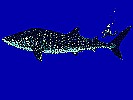

.jpg)
.jpg)
.jpg)
.jpg)
.jpg)
.jpg)
.jpg)
.jpg)
.jpg)
.jpg)
.jpg)
.jpg)
.jpg)
.jpg)
.jpg)
.jpg)
.jpg)
.jpg)
.jpg)
.jpg)
.jpg)
.jpg)
.jpg)
.jpg)

.jpg)
.jpg)
_Simon_Pierce (1).jpg)
_Simon_Pierce (2).jpg)
_Simon_Pierce (3).jpg)
_Simon_Pierce (4).jpg)
_Simon_Pierce (5).jpg)
_Simon_Pierce (6).jpg)
_Simon_Pierce (7).jpg)
_Simon_Pierce (8).jpg)
_Simon_Pierce (9).jpg)
_Simon_Pierce (10).jpg)
_Simon_Pierce (11).jpg)
_Simon_Pierce (12).jpg)
_Simon_Pierce (13).jpg)
_Simon_Pierce (14).jpg)
_Simon_Pierce (15).jpg)
_Simon_Pierce (16).jpg)
_Simon_Pierce (17).jpg)
_Simon_Pierce (18).jpg)
_Simon_Pierce (19).jpg)
_Simon_Pierce (20).jpg)
_Simon_Pierce (21).jpg)
_Simon_Pierce (22).jpg)
_Simon_Pierce (23).jpg)
_Simon_Pierce (24).jpg)
_Simon_Pierce (25).jpg)
_Simon_Pierce (26).jpg)
_Simon_Pierce (27).jpg)
_Simon_Pierce (28).jpg)
_Simon_Pierce (29).jpg)
_Simon_Pierce (30).jpg)
_Simon_Pierce (31).jpg)
_Simon_Pierce (32).jpg)
_Simon_Pierce (33).jpg)
_Simon_Pierce (34).jpg)
_Simon_Pierce (35).jpg)
_Simon_Pierce (36).jpg)
_Simon_Pierce (37).jpg)
_Simon_Pierce (38).jpg)
_Simon_Pierce (39).jpg)
_Simon_Pierce (40).jpg)
_Simon_Pierce (41).jpg)
_Simon_Pierce (42).jpg)
